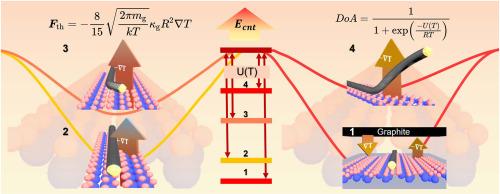External radiative source assisted growth of highly aligned single-walled carbon nanotube array
IF 11.6
2区 材料科学
Q1 CHEMISTRY, PHYSICAL
引用次数: 0
Abstract
Direct growth of single-walled carbon nanotubes (SWNTs) array based on catalyst design is one of the important strategies towards SWNT-based electronic applications, yet facing a fundamental thermodynamic conflict: high temperatures prefer chirality purity but disrupt lattice-aligned growth by amplifying thermophoretic forces (Fth). Here, we resolved this paradox by decoupling catalytic growth and orientation processes through spatially engineered temperature gradients. An external thermal radiation field is introduced to suppress Fth at the catalyst-substrate interface while preserving high-temperature catalytic activity, achieving a lattice orientation and up to tenfold density increasing under conventional non-orientated temperature. Furthermore, experimental and computational simulations quantitively described the transition between lattice orientation and gas flow orientation when temperature increases, and deeply expounded the orientation mechanism with external thermal radiation from the microscopic perspective. This strategy demonstrates the universality across catalysts (quantum dots, Fe and Cu), thus enabling the co-realization of chirality-specific and high-density SWNT arrays, promoting carbon-based electronics toward practical applications.

外辐射源辅助高排列单壁碳纳米管阵列的生长
基于催化剂设计的单壁碳纳米管(SWNTs)阵列的直接生长是基于SWNTs的电子应用的重要策略之一,但面临着一个基本的热力学冲突:高温更倾向于手性纯度,但会通过放大热电泳力来破坏晶格排列的生长(Fth)。在这里,我们通过空间工程温度梯度解耦催化生长和取向过程来解决这个悖论。在保持高温催化活性的同时,引入外部热辐射场抑制催化剂-衬底界面的第五价,实现晶格取向,并在常规无取向温度下将密度提高10倍。实验和计算模拟定量描述了温度升高时晶格取向向气流取向的转变,并从微观角度深入阐述了外加热辐射的取向机理。该策略证明了催化剂(量子点、Fe和Cu)的通用性,从而能够共同实现手性特异性和高密度SWNT阵列,促进碳基电子学走向实际应用。
本文章由计算机程序翻译,如有差异,请以英文原文为准。
求助全文
约1分钟内获得全文
求助全文
来源期刊

Carbon
工程技术-材料科学:综合
CiteScore
20.80
自引率
7.30%
发文量
0
审稿时长
23 days
期刊介绍:
The journal Carbon is an international multidisciplinary forum for communicating scientific advances in the field of carbon materials. It reports new findings related to the formation, structure, properties, behaviors, and technological applications of carbons. Carbons are a broad class of ordered or disordered solid phases composed primarily of elemental carbon, including but not limited to carbon black, carbon fibers and filaments, carbon nanotubes, diamond and diamond-like carbon, fullerenes, glassy carbon, graphite, graphene, graphene-oxide, porous carbons, pyrolytic carbon, and other sp2 and non-sp2 hybridized carbon systems. Carbon is the companion title to the open access journal Carbon Trends. Relevant application areas for carbon materials include biology and medicine, catalysis, electronic, optoelectronic, spintronic, high-frequency, and photonic devices, energy storage and conversion systems, environmental applications and water treatment, smart materials and systems, and structural and thermal applications.
 求助内容:
求助内容: 应助结果提醒方式:
应助结果提醒方式:


